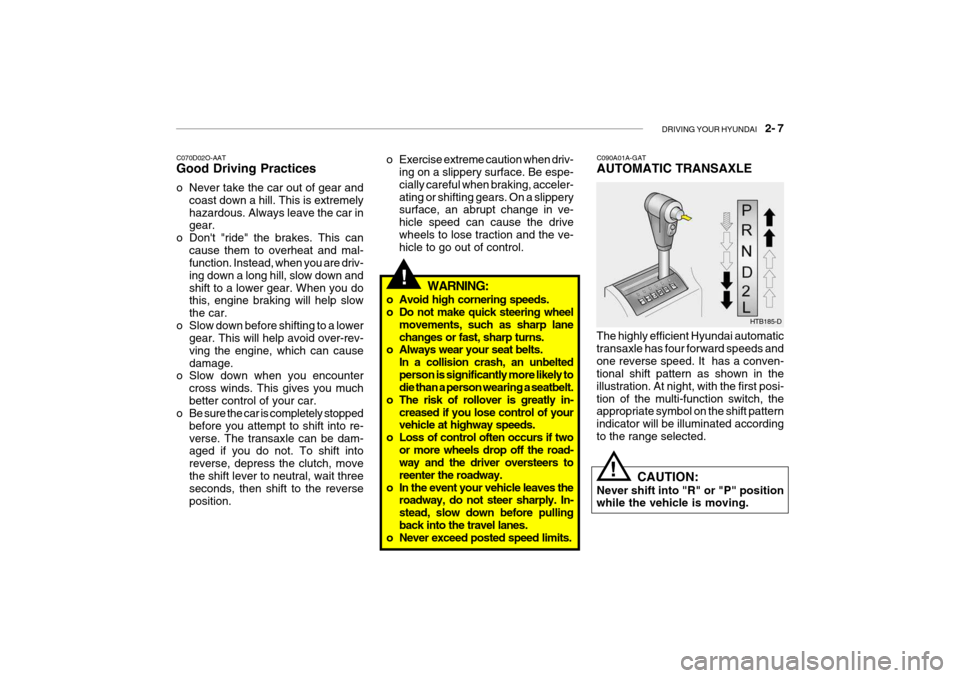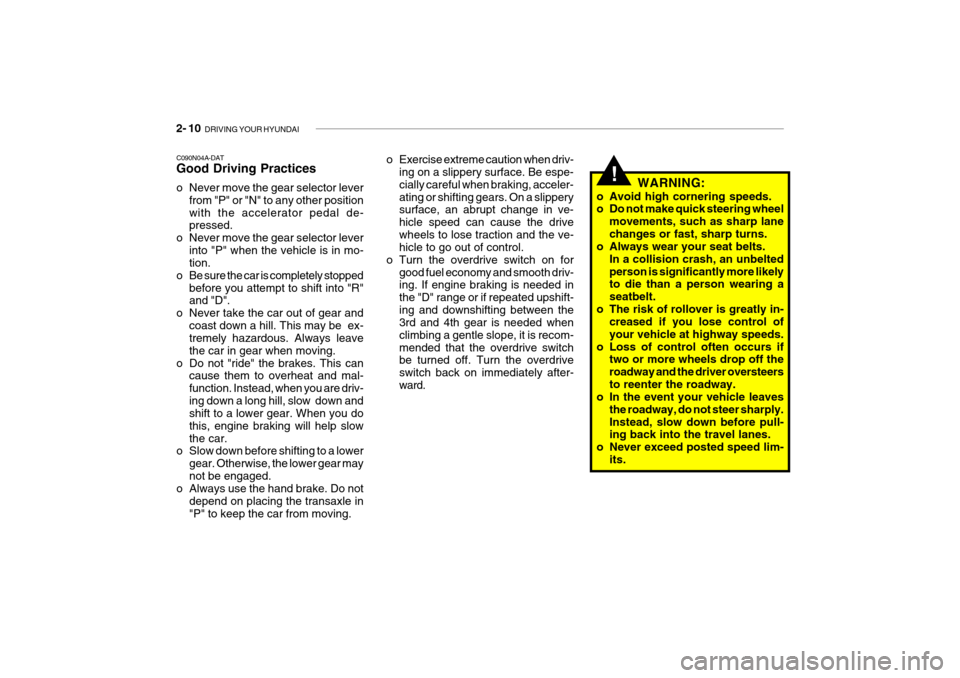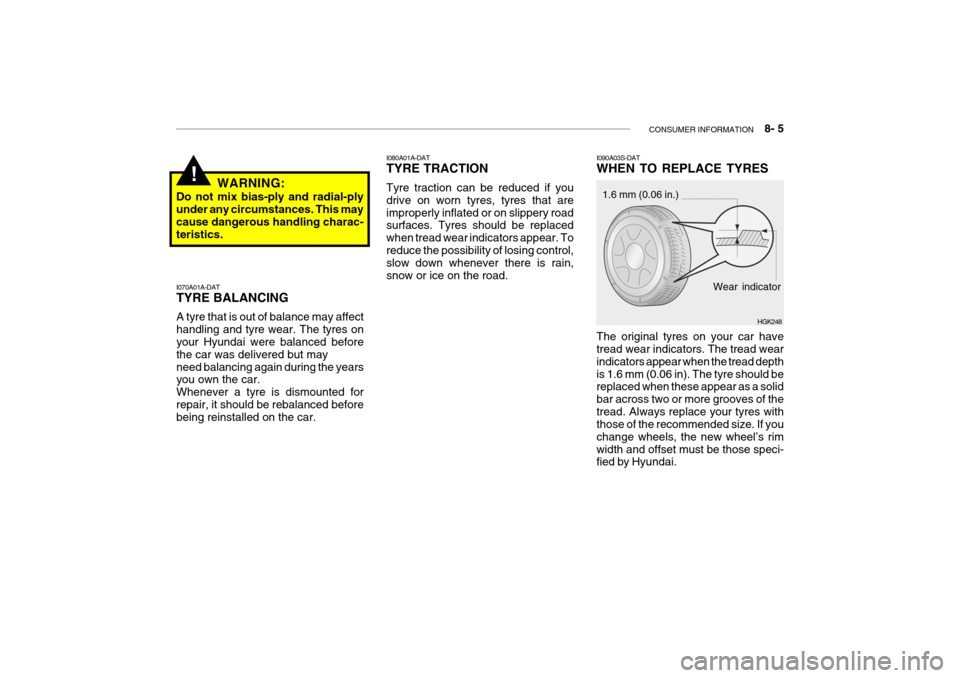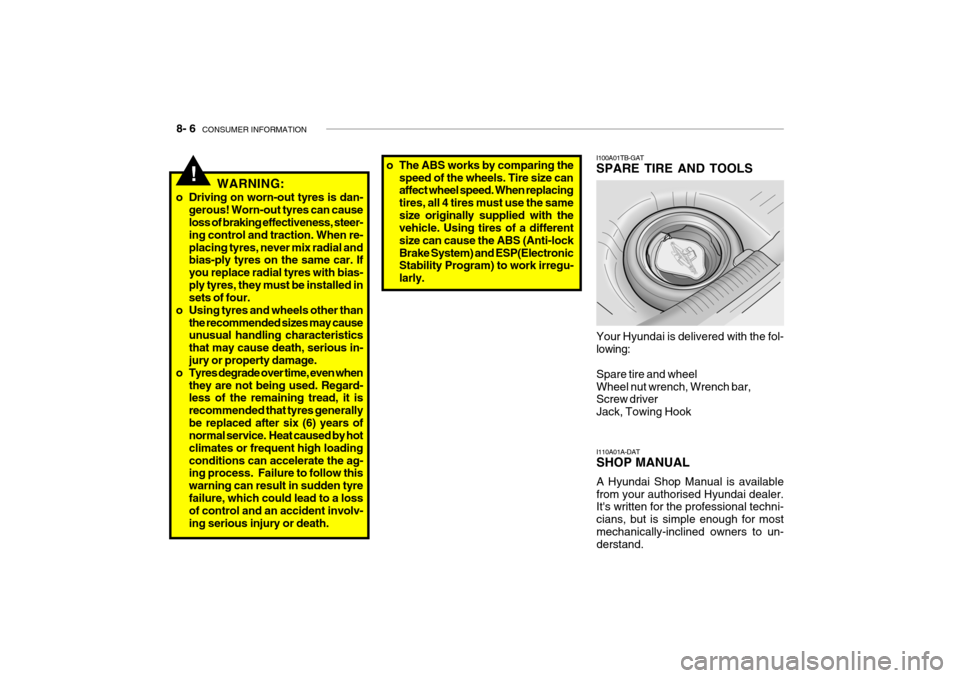2009 Hyundai Getz traction control
[x] Cancel search: traction controlPage 102 of 191

DRIVING YOUR HYUNDAI 2- 7
!
o Exercise extreme caution when driv-
ing on a slippery surface. Be espe- cially careful when braking, acceler-ating or shifting gears. On a slippery surface, an abrupt change in ve- hicle speed can cause the drivewheels to lose traction and the ve- hicle to go out of control.
C070D02O-AAT Good Driving Practices
o Never take the car out of gear and
coast down a hill. This is extremely hazardous. Always leave the car in gear.
o Don't "ride" the brakes. This can
cause them to overheat and mal-function. Instead, when you are driv- ing down a long hill, slow down andshift to a lower gear. When you do this, engine braking will help slow the car.
o Slow down before shifting to a lower gear. This will help avoid over-rev-ving the engine, which can causedamage.
o Slow down when you encounter
cross winds. This gives you muchbetter control of your car.
o Be sure the car is completely stopped
before you attempt to shift into re-verse. The transaxle can be dam- aged if you do not. To shift into reverse, depress the clutch, movethe shift lever to neutral, wait three seconds, then shift to the reverse position. HTB185-D
C090A01A-GAT AUTOMATIC TRANSAXLE
The highly efficient Hyundai automatic transaxle has four forward speeds andone reverse speed. It has a conven- tional shift pattern as shown in the illustration. At night, with the first posi-tion of the multi-function switch, the appropriate symbol on the shift pattern indicator will be illuminated accordingto the range selected. CAUTION:
Never shift into "R" or "P" position while the vehicle is moving.
!
WARNING:
o Avoid high cornering speeds.
o Do not make quick steering wheel movements, such as sharp lane changes or fast, sharp turns.
o Always wear your seat belts.
In a collision crash, an unbeltedperson is significantly more likely to die than a person wearing a seatbelt.
o The risk of rollover is greatly in-
creased if you lose control of yourvehicle at highway speeds.
o Loss of control often occurs if two
or more wheels drop off the road-way and the driver oversteers to reenter the roadway.
o In the event your vehicle leaves the roadway, do not steer sharply. In-stead, slow down before pullingback into the travel lanes.
o Never exceed posted speed limits.
Page 105 of 191

2- 10 DRIVING YOUR HYUNDAI
!
C090N04A-DAT Good Driving Practices
o Never move the gear selector lever
from "P" or "N" to any other position with the accelerator pedal de- pressed.
o Never move the gear selector lever
into "P" when the vehicle is in mo-tion.
o Be sure the car is completely stopped before you attempt to shift into "R"and "D".
o Never take the car out of gear and coast down a hill. This may be ex-tremely hazardous. Always leave the car in gear when moving.
o Do not "ride" the brakes. This can cause them to overheat and mal-function. Instead, when you are driv-ing down a long hill, slow down and shift to a lower gear. When you do this, engine braking will help slowthe car.
o Slow down before shifting to a lower
gear. Otherwise, the lower gear maynot be engaged.
o Always use the hand brake. Do not
depend on placing the transaxle in"P" to keep the car from moving. o Exercise extreme caution when driv-
ing on a slippery surface. Be espe-cially careful when braking, acceler-ating or shifting gears. On a slippery surface, an abrupt change in ve- hicle speed can cause the drivewheels to lose traction and the ve- hicle to go out of control.
o Turn the overdrive switch on for good fuel economy and smooth driv-ing. If engine braking is needed in the "D" range or if repeated upshift-ing and downshifting between the 3rd and 4th gear is needed when climbing a gentle slope, it is recom-mended that the overdrive switch be turned off. Turn the overdrive switch back on immediately after-ward. WARNING:
o Avoid high cornering speeds.
o Do not make quick steering wheel movements, such as sharp lane changes or fast, sharp turns.
o Always wear your seat belts.
In a collision crash, an unbeltedperson is significantly more likely to die than a person wearing a seatbelt.
o The risk of rollover is greatly in- creased if you lose control ofyour vehicle at highway speeds.
o Loss of control often occurs if two or more wheels drop off theroadway and the driver oversteersto reenter the roadway.
o In the event your vehicle leaves
the roadway, do not steer sharply.Instead, slow down before pull- ing back into the travel lanes.
o Never exceed posted speed lim- its.
Page 181 of 191

CONSUMER INFORMATION 8- 5
!
I070A01A-DAT TYRE BALANCING A tyre that is out of balance may affect handling and tyre wear. The tyres on your Hyundai were balanced before the car was delivered but mayneed balancing again during the years you own the car. Whenever a tyre is dismounted forrepair, it should be rebalanced before being reinstalled on the car. I080A01A-DAT TYRE TRACTION Tyre traction can be reduced if you drive on worn tyres, tyres that areimproperly inflated or on slippery road surfaces. Tyres should be replaced when tread wear indicators appear. Toreduce the possibility of losing control, slow down whenever there is rain, snow or ice on the road.
I090A03S-DAT WHEN TO REPLACE TYRESWear indicator
1.6 mm (0.06 in.)
HGK248
WARNING:
Do not mix bias-ply and radial-ply under any circumstances. This may cause dangerous handling charac-teristics.
The original tyres on your car have tread wear indicators. The tread wear indicators appear when the tread depthis 1.6 mm (0.06 in). The tyre should be replaced when these appear as a solid bar across two or more grooves of thetread. Always replace your tyres with those of the recommended size. If you change wheels, the new wheel’s rimwidth and offset must be those speci- fied by Hyundai.
Page 182 of 191

8- 6 CONSUMER INFORMATION
I100A01TB-GAT SPARE TIRE AND TOOLS
Your Hyundai is delivered with the fol- lowing: Spare tire and wheel Wheel nut wrench, Wrench bar, Screw driver Jack, Towing Hook HTB224
I110A01A-DAT SHOP MANUAL A Hyundai Shop Manual is available from your authorised Hyundai dealer. It's written for the professional techni- cians, but is simple enough for mostmechanically-inclined owners to un- derstand.
!WARNING:
o Driving on worn-out tyres is dan- gerous! Worn-out tyres can cause loss of braking effectiveness, steer- ing control and traction. When re-placing tyres, never mix radial and bias-ply tyres on the same car. If you replace radial tyres with bias-ply tyres, they must be installed in sets of four.
o Using tyres and wheels other than
the recommended sizes may causeunusual handling characteristics that may cause death, serious in- jury or property damage.
o Tyres degrade over time, even when
they are not being used. Regard-less of the remaining tread, it is recommended that tyres generallybe replaced after six (6) years of normal service. Heat caused by hot climates or frequent high loadingconditions can accelerate the ag- ing process. Failure to follow this warning can result in sudden tyrefailure, which could lead to a loss of control and an accident involv- ing serious injury or death. o The ABS works by comparing the
speed of the wheels. Tire size can affect wheel speed. When replacing tires, all 4 tires must use the samesize originally supplied with the vehicle. Using tires of a different size can cause the ABS (Anti-lockBrake System) and ESP(Electronic Stability Program) to work irregu- larly.